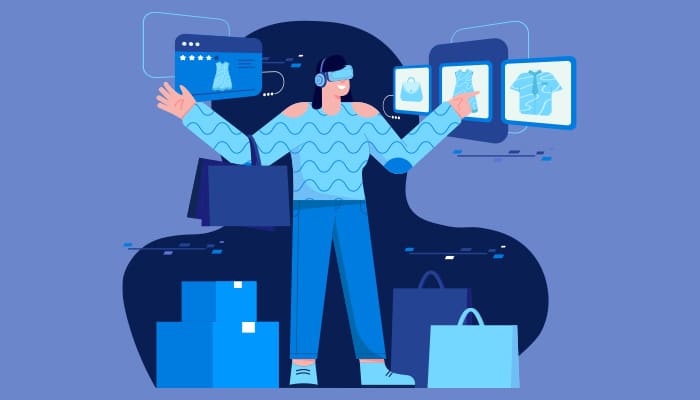In the ever-evolving eCommerce industry, staying updated on the latest trends isn’t just a strategy; it’s a necessity. One of the latest advancements in technology attracting the spotlight is Augmented Reality (AR) and Virtual Reality (VR) integration. These engaging technologies aren’t only sci-fi fantasies any longer; they are actively changing the way we shop online. Let’s explore how AR and VR are transforming the eCommerce ecosystem, improving customer experiences, and reforming the development workflow.
The Rise of AR and VR in E-Commerce
Over the years, Augmented Reality (AR) and Virtual Reality (VR) have been the forces behind the transformation of the eCommerce sector, reforming the way consumers shop for products and services online. Exceeding the capabilities of customary online retail, these immersive technologies have transformed product visualization.
AR allows customers to try products virtually in their personal spaces, from trying on clothing to placing furniture, eradicating the ambiguity related to digital shopping. However, VR generates engaging virtual showrooms, offering an enjoyable and immersive simulated environment to explore products. These technologies not only improve the online shopping experience but also enable consumers to make confident and well-informed purchase decisions.
In eCommerce, AR and VR integration extends improving product visualization; it primarily transforms how users engage with online brands. These advancements augment customer engagement by making your shopping experience an engaging journey. Gamified shopping apps, virtual storefronts, and interactive ads driven by AR and VR attract users, leaving the shopping experience not only transactional but entertaining. Moreover, AR’s engaging content and VR’s sense of presence result in a more customized shopping journey.
Actionable insights associated with customer behaviors enable eCommerce platforms to provide tailored suggestions, while AR’s virtual try-on feature and VR’s engaging environments deliver an exclusive online shopping adventure. With these evolving technologies, enterprises implementing AR and VR are not solely abiding by current trends but are charting the future of eCommerce, ensuring a customer-centric and immersive landscape.
Here are the top 4 benefits of integrating Virtual Reality and Augmented Reality in business:
- Boosting Product Visualization
One of the major challenges in shopping online has constantly been the need for physical interaction with products before the purchase. AR and VR integration close this gap by allowing customers to try out products virtually. One of the Augmented Reality eCommerce examples is customers visualizing how furniture can be placed in their house or trying on clothes virtually before choosing the size or style. This not only lowers the ambiguity related to online shopping but also offers a component of personalization and fun.
- Improving Customer Engagement
AR and VR offer an unmatched level of interactivity, changing the standard experience of online shopping into an adventure. By integrating these technologies, various eCommerce platforms can generate virtual stores where users can view products in a more engaging and dynamic way. Particularly, VR can transport customers to a virtual store or even a simulated environment associated with the product they want to purchase. This increased engagement level often evolves into heightened brand loyalty and customer satisfaction.
- Personalizing the Shopping Journey
Within the age of personalized experiences, AR and VR are playing a vital role in customizing the shopping journey for every user. With such advancements, eCommerce platforms can examine buying history, user preferences, and behavior to deliver personalized suggestions. Particularly, AR can leverage real-world insights to recommend products that effortlessly match a customer’s preferences or lifestyle.
- Streamlining the Development Workflow
While the advantages for customers are evident, AR and VR integration also streamline the development process in eCommerce. Several tools and platforms are available to seamlessly integrate AR and VR into prevailing eCommerce systems. Developers can utilize AR and VR SDKs (Software Development Kits) to foster engaging experiences without starting afresh. This not only helps save time and resources but also motivates more eCommerce companies to embrace these game-changing technologies.
From Hurdles to High-Tech: AR & VR Integration Made Effortless
While Augmented Reality (AR) and Virtual Reality (VR) integration into eCommerce welcomes a plethora of avenues, it isn’t without its allied challenges. Navigating these challenges is vital for completely leveraging AR and VR technologies in the realm of online shopping.
- Technological Barriers
One significant challenge is the device and platform diversity. AR and VR applications need to deal with distinct operating systems, hardware capabilities, and device specifications. This division can lead to compatibility problems, making it tough for developers to build seamless experiences for a wide diversity of devices.
To counter this challenge, developers are gradually leveraging cross-platform development frameworks and standards to foster robust user experiences. In addition, regular advancements in hardware are incrementally bridging the gap, making AR and VR apps easily accessible to a larger audience.
- Quality of Content
One more noteworthy hurdle in the integration of AR/VR is the need for top-grade 3D models and content. The impact of these engaging technologies depends heavily on engaging and realistic visual elements. Building accurate and extensive 3D models can be time-consuming and resource-intensive, posing an obstacle for enterprises with budget constraints or strict development timelines.
However, with the introduction of solutions such as 3D scanning technologies and AI-driven content creation tools, the process of creating high-quality AR/VR content has been streamlined. Such advancements enable businesses to counter the challenge of content creation, ensuring that these engaging experiences satisfy upscale consumers.
- User Adoption & Learning Curve
A significant aspect that can’t be skipped is the rate of user adoption. Even though Gen Z may promptly adopt AR and VR, a major chunk of the consumer base is still unaccustomed to such technologies. The learning curve linked to navigating AR and VR apps may hamper extended adoption.
To tackle this issue, companies are spending on responsive user interfaces, extensive customer support, and interactive tutorials to assist users through their first experiences. In addition, marketing campaigns and educational initiatives play a crucial role in debunking such technologies, focusing on their practical advantages, and building a more receptive consumer base.
- Data Security & Privacy Concern
Integrating AR and VR into eCommerce includes activities like gathering and processing sensitive user data. Privacy issues and the likely misuse of sensitive data represent major obstacles to widespread adoption. Businesses are navigating these problems by employing robust data security policies and measures, transparent privacy policies, and adherence to industry standards. Blockchain technology is also posing as a likely solution to boost data security, offering users added control over their data.
The AR and VR integration process is evolving gradually in addressing these challenges. Technological advancements, industry collaboration, and dedicated user education and experience can drive the emergence of solutions that vouch to make AR and VR not only immersive technologies but vital components of the eCommerce landscape. As enterprises address these challenges, the captivating future of online shopping beckons, where AR and VR flawlessly enhance the user experience.
Long Story Short
In eCommerce development, AR and VR integration isn’t just a trend; it’s a radical shift. The capability to boost product visualization, enhance customer engagement, personalize the shopping experience, and streamline the development process makes AR and VR essential tools for eCommerce companies who want to stay competitive in the digital era. As technology is constantly evolving, the future of online shopping promises to be more immersive, engaging, and personalized than ever before.







